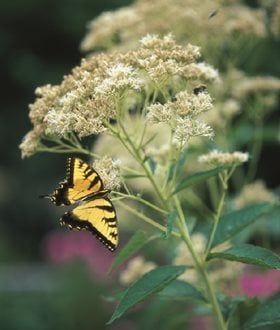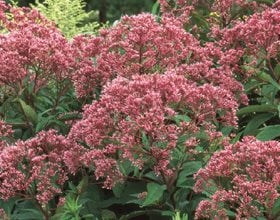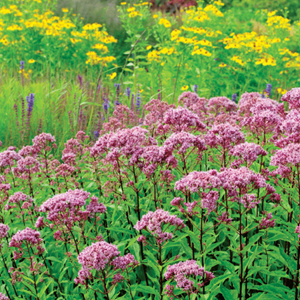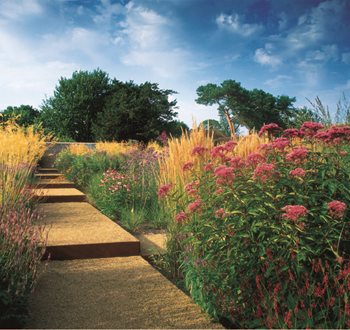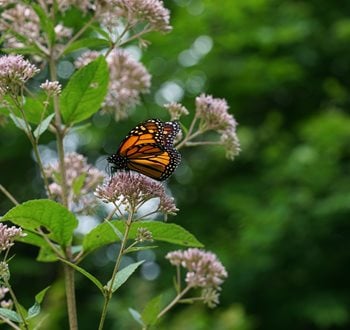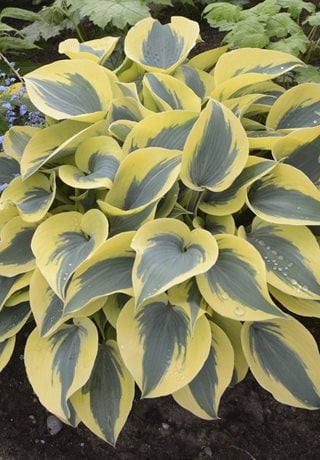Joe Pye Weed
Grow these statuesque and showy native wildflowersLATIN NAME:
Eutrochium purpureum (formerly Eupatorium purpureum)
APPEAL:
Exuberant growth culminating in 7- to 12-inch-wide, nectar- and pollen-rich flower clusters in fall that bees, butterflies and insects crave.
ZONES:
3 to 9, depending on variety
SOIL:
Rich and moist
SIZE:
Grows to 6 to 8 feet high by 3 feet wide. It is not well suited for small spaces, as it needs plenty of room to grow.
EXPOSURE:
Full sun
CARE:
Plants are most vigorous when they have more moisture; however, once established they will survive brief periods of drought (but may experience some leaf scorching). Pinch growth buds (even cut plants back by half) in early summer to make plants stockier with smaller but more abundant flowers. Divide plants in spring shortly after new growth appears or in fall. Easy to grow from seed.
Purchase Joe Pye weed seeds on Amazon.
SPECIES AND VARIETIES:
Eutrochium purpureum, sweet Joe Pye weed, grows in the eastern U.S. It has purple flowers, mostly green stems and a vanilla scent. ‘Bartered Bride’ is white form. Eutrochium maculatum, spotted Joe Pye weed is similar to E. purpureum. ‘Gateway’ is shorter. ‘Atropurpureum’ has wine colored stems and dusky rose flowers.
LEGEND:
Joe Pye was an Indian medicine man in New England who cured typhus with E. purpureum. Eupatorium perfoliatum, boneset, is said to have relieved symptoms of break-bone (dengue) fever.
REASONS TO LOVE JOE PYE WEED:
- Easy to grow
- Low-maintenance
- Attracts pollinators
- Deer-resistant
- Late season bloomer
- No serious insect or disease problems
DESIGN IDEAS:
Incorporate into a perennial meadow.
Dutch designer Piet Oudolf grows Joe Pye weed on his own property alongside other perennials and grasses in a random fashion that appears natural.
See more of Piet Oudolf’s garden.
Add spontaneity to a modern garden.
British designer Christopher Bradley-Hole used Joe Pye weed, drifts of grasses and other perennials to flank a grid of steel-edged garden paths.
See more of Bradley-Hole’s designs.
Sit back and enjoy the butterflies.
A monarch enjoys the nectar of Eutrochium fistulosum (Joe Pye weed) in Rick Darke’s garden. Place a bench or chairs nearby so you can watch the show.
See more of Rick Darke’s garden.
More Tips:
- Joe Pye weed’s height makes it a good option for the back of the border
- It also works well in cottage gardens for extending the season—get ideas for an enticing cottage garden
- Great for planting in or near rain gardens, as Joe Pye weed will tolerate wet soil
WHAT TO PLANT WITH JOE PYE WEED:
- Calamagrostis ‘Karl Foerster’ (feather reed grass)
- Echinacea (coneflower)
- Helenium (sneezeweed)
- Monarda bradburiana (Eastern bee balm)
- Panicum virgatum (switchgrass)
- Persicaria (knotweed)
- Pycnanthemum muticum (mountain mint)
- Vernonia (ironweed)
RELATED:
20+ Rain Garden Plants
Late Blooming Plants
Butterfly Garden Plants
